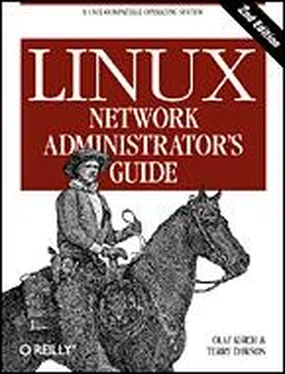A simple example inn.conf might look like:
# Sample inn.conf for the Virtual Brewery
server: vlager.vbrew.com
domain: vbrew.com
fromhost: vbrew.com
pathhost: news.vbrew.com
organization: The Virtual Brewery
mta: /usr/sbin/sendmail -oi %s
moderatormailer: %s@uunet.uu.net
#
# Paths to INN components and files.
#
pathnews: /usr/lib/news
pathbin: /usr/lib/news/bin
pathfilter: /usr/lib/news/bin/filter
pathcontrol: /usr/lib/news/bin/control
pathdb: /var/lib/news
pathetc: /etc/news
pathrun: /var/run/news
pathlog: /var/log/news
pathhttp: /var/log/news
pathtmp: /var/tmp
pathspool: /var/spool/news
patharticles: /var/spool/news/articles
pathoverview: /var/spool/news/overview
pathoutgoing: /var/spool/news/outgoing
pathincoming: /var/spool/news/incoming
patharchive: /var/spool/news/archive
pathuniover: /var/spool/news/uniover
overviewname: .overview
The first line tells the programs rnews and inews which host to contact when delivering articles. This entry is absolutely crucial; to pass articles to innd, they have to establish an NNTP connection with the server.
The domain keyword should specify the domain portion of the host's fully qualified domain name. A couple of programs must look up your host's fully qualified domain name; if your resolver library returns the unqualified hostname only, the name given in the domain attribute is tacked onto it. It's not a problem to configure it either way, so it's best to define domain .
The next line defines what hostname inews is going to use when adding a From: line to articles posted by local users. Most newsreaders use the From: field when composing a reply mail message to the author of an article. If you omit this field, it will default to your news host's fully qualifed domain name. This is ot always the best choice. You might, for example, have news and mail handled by two different hosts. In this case, you would supply the fully qualified domain name of your mail host after the fromhost statement.
The pathhost line defines the hostname INN is to add to the Path: header field whenever it receives an article. In most cases, you will want to use the fully qualified domain name of your news server; you can then omit this field since that is the default. Occasionally you may want to use a generic name, such as news.vbrew.com, when serving a large domain. Doing this allows you to move the news system easily to a different host, should you choose to at some time.
The next line contains the organization keyword. This statement allows you to configure what text inews will put into the Organization: line of articles posted by your local users. Formally, you would place a description of your organization or your organization's name in full here. Should you not wish to be so formal, it is fashionable for organizations with a sense of humor to exhibit it here.
The organization keyword is mandatory and specifies the pathname of the mail transport agent that will be used for posting moderator messages. %s is replaced by the moderator email address.
The moderatormailer entry defines a default address used when a user tries to post to a moderated newsgroup. The list of moderator addresses for each newsgroup is usually kept in a separate file, but you will have a hard time keeping track of all of them. The moderatormailer entry is therefore consulted as a last resort; if it is defined, inews will replace the %s string with the (slightly transformed) newsgroup name and send the entire article to this address. For instance, when posting to soc.feminism, the article is mailed to soc-feminism@uunet.uu.net , given the above configuration. At UUNET, there should be a mail alias installed for each of these submissions addresses that automatically forwards all messages to the appropriate moderator.
Finally, each of the remaining entries specifies the location of some component file or executable belonging to INN. If you've installed INN from a package, these paths should have been configured for you. If you're installing from source, you'll need to ensure that they reflect where you've installed INN.
The news administrator on a system is able to control which newsgroups users have access to. INN provides two configuration files that allow the administrator to decide which newsgroups to support and provide descriptions for them.
The active and newsgroups files
The active and newsgroups files are used to store and describe the newsgroups hosted by this news server. They list which newsgroups we are interested in receiving and serving articles for, and administrative information about them. These files are found in the /var/lib/news/ directory.
The active file determines which newsgroups this server supports. Its syntax is straightforward. Each line in the active file has four fields delimited by whitespace:
name himark lomark flags
The name field is the name of the newsgroup. The himark field is the highest number that has been used for an article in that newsgroup. The lomark field is the lowest active number in use in the newsgroup. To illustrate how this works, consider the follow scenario. Imagine that we have a newly created newsgroup: himark and lowmark are both 0 because there are no articles. If we post 5 articles, they will be numbered 1 through 5. himark will now equal 5, the highest numbered article, and lowmark will equal 1, the lowest active article. If article 5 is cancelled there will be no change; himark will remain at 5 to ensure that that article number is not reallocated and lowmark will remain at 1, the lowest active article. If we now cancel article 1, himark will remain unchanged, but lowmark will now equal 2, because 1 is no longer active. If we now post a new article, it will be assigned article number 6, so himark will now equal 6. Article 5 has been in use, so we won't reassign it. lowmark remains at 2. This mechanism allows us to easily allocate unique article numbers for new articles and to calculate approximately how many active articles there are in the group: himark - lowmark .
The field may contain one of the following:
y
Posting directly to this news server is allowed.
n
Posting directly to this news server is not allowed. This prevents newsreaders from posting directly to this news server. New articles may only be received from other news servers.
m
The group is moderated. Any articles posted to this newsgroup are forwarded to the newsgroup moderator for approval before they enter the newsgroup. Most newsgroups are unmoderated.
j
Articles in this group are not kept, but only passed on. This causes the news server to accept the article, but all it will do with it is pass it to the "up-stream" news servers. It will not make the articles available to newsreaders reading from this server.
x
Articles cannot be posted to this newsgroup. The only way that news articles are delivered to this server is by feeding them from another news server. Newsreaders may not directly write articles to this server.
Читать дальше



![Andrew Radford - Linguistics An Introduction [Second Edition]](/books/397851/andrew-radford-linguistics-an-introduction-second-thumb.webp)








